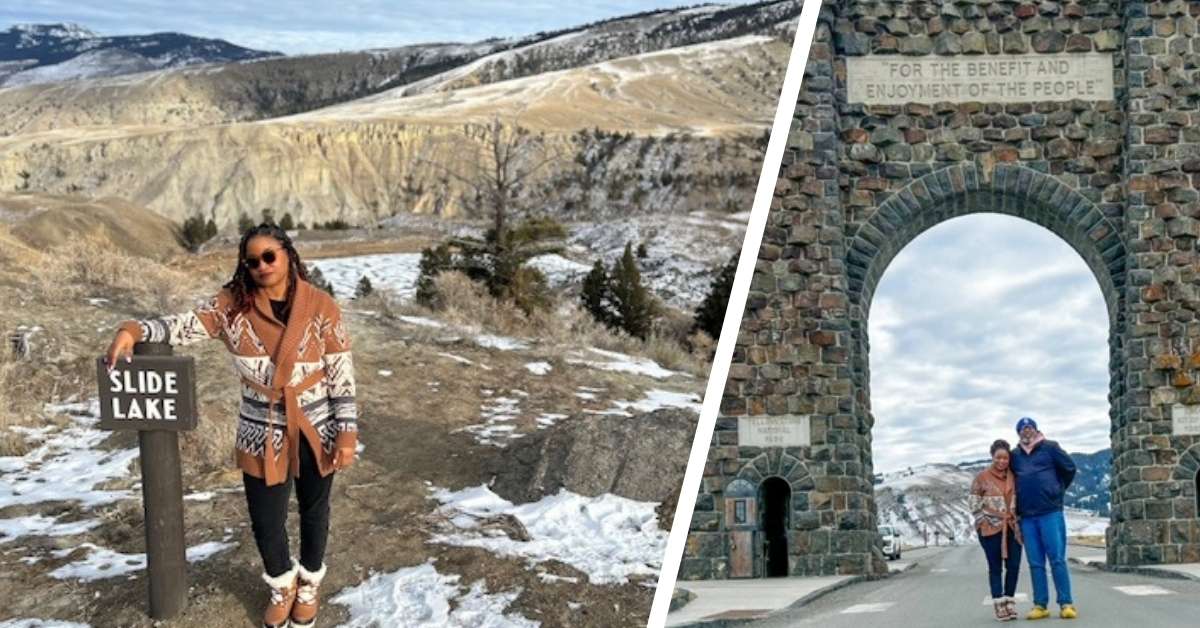Over winter break, my family and I climbed into our Ford pickup and traveled to Yellowstone National Park in Montana. The drive allowed us to take in breathtaking views from the Badlands, to snow-covered mountains, to the Yellowstone River. Inside the park, we got to hike, visit the hot springs, and see bison, wolves, eagles, and other creatures. It was a quick but restorative experience. Photos cannot truly capture the majesty of this park, though we tried.
While we were there, I thought a lot about how ancient the land was. The Museum of the Rockies in Bozeman, MT focuses on the cultural and natural history of the region, including a full skeleton of a Tyrannosaurus rex. I marveled at the thought of ancient animals like dinosaurs and wooly mammoths roaming the valleys, looking for food, and finding places to hibernate during the long dark winters. Even during the off-season we encountered many other visitors, all of us eager to learn and explore. The visitor center featured displays of animals we might see, how to stay safe, and referenced the 26 Tribal nations associated with the Yellowstone area, which covers parts of three states. What I didn’t know was how many, if any, people representing those nations were at the park at that very moment. And I didn’t learn their stories.
Before it was established as Yellowstone by Ulysses Grant more than 150 years ago, Native peoples played, worshiped, hunted, and lived there for at least 11,000 years. They had different names for the land, including ‘land of the hot water,’ and ‘many smoke.’ Much of this history has been intentionally erased as part of the American land discovery mythology, and the subjugation and theft that followed. Even though we know this, via oral history and archeology, there remains a gap in common knowledge and the materials within the park. As one University of Montana anthropology professor put it, “The marketing hasn’t caught up with the research.”
While people of the Blackfeet, Coeur d’Alene, and many other Tribal nations nurtured the land and animals of what is now Yellowstone for hundreds of years, they are currently reduced to a simple plaque and souvenirs for sale in the general store. The words over the original entrance of the park read: “for the benefit and enjoyment of the people.” But I’m not sure I would classify the park as accessible to all people, let alone the original stewards. The stories of violent dispossession are important history, and deserve redress. I believe that Yellowstone and other public lands should be returned to the Tribes for caretaking. This movement, known as ‘land back,’ is growing.
Recently, the state of Minnesota has decided to return some land to local tribes. This month, the Minnesota Department of Natural Resources (DNR) announced that it would close Upper Sioux Agency State Park and return it to the Upper Sioux community. Many Dakota people starved and died at the site in 1862, as a result of a broken treaty signed by the U.S. government. The DNR noted that using the site for recreation was inconsistent with its unique history and that the park will close to the public on February 16, 2024. In another example, a plot of land in Lake City that contains the remains of Dakota relatives, is being returned to the Prairie Island community to manage.
Our National Parks are not new discoveries, and we are not telling the full stories of how they came to be the property of the U.S. Government. Further, the ‘pre-historical’ story of the land and its flora and fauna could prove incredibly useful in their long-term care. Any conversation about antiracism and decolonization needs to include how we tell the stories of the land and how we return the management of the land to its Indigenous caretakers. The land back movement forces us to think about sacred spaces, traditional knowledge, and sustainable ways of caring for the land, water, and animals. Healthy water, land, and animals promote public health because they help lead to healthy people. Everyone benefits from this approach. Let us reconsider our relationships with our Indigenous neighbors, and how we can partner toward justice and well-being.
Resources:
- The Lost History of Yellowstone
- The history and traditions of indigenous people in Yellowstone
- What is land back?
Toward justice,
Lauren Jones
Director, Diversity, Equity, and Inclusion
UMN School of Public Health
she/her/hers

